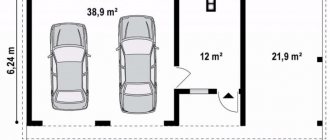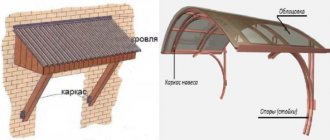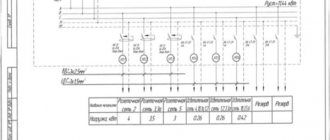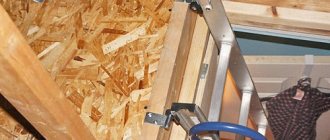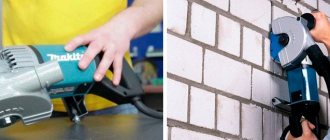Home » Building a house » Do it yourself
Vladimir 03/28/2020
1467 Views
Probably everyone who values comfort has a device such as an air conditioner. In hot weather, this is just right. Don't have an air conditioner yet and want to install it yourself? Then this one is just for you. If you don’t like to waste your money, then you need to buy such equipment out of season when it is in demand.
Air conditioning kit and installation equipment
Read also: Air conditioning for an apartment: how not to make a mistake and choose the best option for your home | 2019
Installation of the external air conditioner unit
Installing a device with your own labor is a job in which there are many little details; if you miss them, it leads to wear and tear of the equipment. But if you decide to install it without the help of professionals, we advise you to follow the instructions below.
The electric air conditioner kit includes the following components:
- Outdoor unit
Outdoor unit
- Indoor unit
Indoor unit
- Metal frame. Used for installation
Metal frame
- Nuts, self-tapping screws with dowels (for fastening the frame)
Nuts, self-tapping screws with dowels (for fastening the frame)
- Drainage tubes. Used to remove moisture
Drainage tubes
- Remote control for the device
Remote control for the device
- Instructions
When installing the mechanism yourself, an addition to the standard package is required. They consist of the following components:
- electrical cables. Most often, four-core cables with a length of about 30 cm are used.
- brackets for mounting an outdoor model
- Copper tubes with plugs. The length of the tube corresponds to the length of the route
- thermal insulation. Its length is equal to the length of the route * 2
- reinforced tape
Copper fittings for air conditioning
If the device is already a verse, you should choose a location for installation. We take into account the following factors:
- device requirements
- maximum length and width of side parts
- installation of the outer part. Not all buildings can be equipped with an outdoor unit. If there is nowhere to attach it, then they usually put it on the balcony
Tools and equipment for work
Installation equipment:
- Hammer with drill (length 45 mm)
- Vacuum pump
- Collector
Set of tubular products, for fastening
set :
- 2 copper pipes; diameter of one is 6.35mm, the other is 9.52mm
- Insulation
- Drainage hose
- Wiring
- Mounting bracket
Basic mistakes
There are several mistakes that almost everyone makes when installing a split system:
- Pipes are laid with kinks. This increases the load on the compressor.
- External units are mounted on a glazed balcony. This negatively affects the quality of air circulation.
- Placing a split system near welding machines.
- Uneven placement of blocks. Condensation may drip onto the floor, distorting it.
- Purchasing an air conditioner that does not have an “auto defrost” option. When the “heating” mode is turned on, the external unit will begin to become covered with ice.
It is useful to know how to connect an air conditioner at home. It is better if you have an assistant, since the systems are quite heavy.\
Starting the system
Read also: Do-it-yourself false fireplace from scrap materials: 140 photos in the interior, assembly video + step-by-step instructions
Pressure gauge needles, pressure check, plugs
First you need to start a split system. Here you need to follow the recommendations:
- Connect the large pipe to the port that is on the gas side
- Connect the middle hose to the pump, close all taps
- Turn on for 20 minutes. Afterwards, turn off the pump and watch the pressure gauge needle for 20 minutes
- If the pressure gauge rises to zero, then it is worth redoing your system
- Turn on the air conditioner and check its operation (when the pressure rises, unscrew the hose and put plugs on the edges)
Requirements for installation of the indoor unit
There are the following rules for placing the indoor air conditioner unit in a room:
- the distance between the hair dryer and the ceiling must be at least 15 cm (some models are installed at a distance of 20-30 cm from the ceiling);
- the distance from the installed block to the wall on the right or left is at least 30 cm;
- the obstacle in the path of air flow should be no closer than 150 cm.
Sometimes the question arises: at what height should I hang the indoor module if the room has high ceilings? On average, you can hang an air conditioner on the wall at a height of 280 cm from the floor, as shown in the figure.
The following figure shows examples of various installation options, clearly showing how best to install the air conditioner.
Safety
Read also: Secrets of soundproofing walls in an apartment: we use modern materials and technologies (25+ Photos & Videos) + Reviews
Damaged air conditioner
The electrical connection diagram must comply with the “Electrical Installation Rules”, since the air conditioner is a high-power device. Before you buy a device, you need to calculate the power of your electrical devices and compare all the restrictions. Otherwise, this may lead to emergency situations.
Requirements for installation of the outdoor unit
The external module of the unit is usually placed under a window, near a window or on a balcony. If the balcony fence is strong enough, then you can fix the module on it.
If the apartment is on the ground floor, then the outdoor unit must be located at a height of at least 2 meters from the ground, adhering to the rule: the outdoor unit must be mounted slightly lower than the indoor unit, or at the same level with it.
When installing split system modules, you should remember the minimum and maximum distances between them . These values may differ between different HVAC manufacturers. For example, for Panasonic split systems the minimum distance between modules can be 3 meters, and for Daikin – from 1.5 to 2.5 meters.
Some manufacturers do not specify a minimum distance at all. In this case, the blocks can be placed back to back.
The maximum length of the route between modules is usually 6 meters. More is allowed, but in such a situation it will be necessary to refill with freon, which entails additional material investments. Therefore, if you install the air conditioner yourself, it is better not to exceed the designated 6 meters.
Vacuuming
Read also: Decorating the hallway with decorative stone: types of finishing stone, do-it-yourself arrangement (100+ Photos & Videos)
Evacuation of the air conditioner
To remove moisture, the system is evacuated. Connect the air conditioner to the vacuum pump for about 1 hour. Freon is pumped into the system from the factory, we must connect a pressure gauge to control the pressure.
After this, the automatic separator is turned on, and the system automatically goes into test mode.
In a word, installation and installation of an air conditioner is a complex and responsible matter, so some owners call specialists from the supplier. But unfortunately, not everyone can afford it. Therefore, when installing yourself, do not forget about safety precautions.
Video materials:
Air conditioner installation, errors, tools! (Theory)
Installing an air conditioner in an apartment or private house: step-by-step instructions for do-it-yourself installation | Photo & Video
Air conditioner installation! (DETAILED TRAINING IN 5 MIN)
Installing an air conditioner in an apartment or private house: step-by-step instructions for do-it-yourself installation | Photo & Video
Troubleshooting yourself
If your air conditioner suddenly stops cooling the air in the room entrusted to it, you can independently determine the cause of the problem:
- Does not work. The reason may be a lack of power supply. Occurs due to a damaged plug or cord, a blown fuse, or a lack of voltage in the electrical network.
- Poor cooling. Air flow is obstructed by a dirty filter, an obstruction, or a nearby heat-generating appliance.
- Doesn't heat well. The heat exchanger located outside is frozen, which prevents air circulation.
A normally operating window air conditioner will make a barely audible click when the thermostat starts and stops, and after the compressor is turned off, the fan will still run for a short period of time.
Monoblock features
This monoblock is inferior to split devices in the following parameters:
- noise level;
- productive capacity;
- functional;
- design;
- overall dimensions, etc.
Under certain conditions, it can become an alternative option to a split, floor-standing monoblock:
- it is impossible to install an external split block on the facade of a building that is of historical and cultural value;
- the decorative covering of the facade is dilapidated and crumbling;
- limited budget;
- impossibility of carrying out installation work inside the walls;
- relative mobility when moving or installing in another room.
Inside the common housing there are the necessary elements: heat exchangers, fans for them, a compressor, a thermostatic valve, a freon circuit, a drain tank, an automatic control unit, and air distributors.
The noise level of 50 dB is due to the placement of a compressor and heat exchange fans in a single housing, creating a noise flow. With proper installation, this effect can be reduced by high-quality noise insulation and reliable fastening.
general information
From the history of air conditioners, we know that the first truly mass-produced devices appeared in the USA at the beginning of the 20th century. They were quite bulky and noisy, and also toxic, as they emitted dangerous fumes.
But progress did not stand still; air conditioners became safe and compact. In the middle of the last century, America was swept by a wave of popularity of window air conditioners. Any average family could afford to purchase such a device, so they were produced on a huge scale.
Historically, most windows in America have one sash that goes up. Of course, air conditioner manufacturers took this feature into account and therefore manufactured units of such a shape and size that the air conditioner could easily fit into the window opening of a typical American home.
As a result, this format became the standard, and most manufacturers still produce window air conditioners aimed at the Western market. But our windows look completely different! They have at least one door that swings open to the side. And in modern plastic windows there are two or three such sashes.
However, this feature did not particularly affect the market for window air conditioners in Russia and the CIS countries. Our craftsmen adapted to the dimensions of American “windows” and came up with ways to install such devices even in a plastic window.
Nowadays, the popularity of window air conditioners is not as great as it used to be. They were replaced by split systems. They are more expensive, but more effective, more aesthetically pleasing and simply more convenient to use. And the frame does not have to be adjusted to the size of the device.
However, window air conditioners are still available in the market. After all, they have a number of significant advantages:
- Compactness;
- Low price;
- Uninterrupted operation;
- Ease of maintenance and cleaning.
By the way, a monoblock type air conditioner also has all these advantages; it is also called a mobile air conditioner. This is a more modern and convenient replacement for the “window”. If you don't know what a candy bar is, read the article below.
Do I need permission?
People often ask whether permission is needed to install a split system, and is it possible to install it without approval from the authorities? Based on practice, permission to install an air conditioner is not required. An exception may be cases when it is necessary to coordinate the installation of climate control equipment with the authorities in buildings that are architectural monuments or have historical or aesthetic value. In other cases, approval is not required for the installation of climate control equipment.


